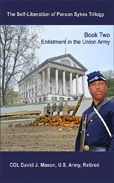
 |
The Self-Liberation of Parson Sykes: Enlistment in the Union Army
by COL David J. Mason, U.S. Army, Retired
HMG ePublishing
After escaping the plantation in an act of self-liberation, Parson Sykes makes his way thorough southeastern Virginia to reach a Union contraband camp. Sykes is determined that the best way to secure his freedom, fight against slavery, and become a respected and independent man is to join the Union’s forces and be an active participant in the fight against the Confederacy. Sykes and his brothers join the Union Army as part of the XXV Corps. Sykes must learn how to be a soldier and fight against the often-held belief that Black soldiers are meek and not cut out for fighting. He and other Black soldiers must face many challenges, like being offered inadequate equipment and given the worst assignments. Also, many Confederate soldiers don’t treat captured Black soldiers properly as POWs. Sykes does his best to meet the challenges with dignity and honor and to prove to everyone that he deserves the chance to fight against enslavement and to overcome its monstrous embodiment as equally as any other man. Sykes and the XXV Corps are part of the offensive that eventually takes the Confederate capital of Richmond and brings an end to the Civil War.
Anyone who has seen the movie Glory will likely draw instant parallels between that film and Mason’s book. For example, both discuss some of the first African American soldiers serving in the Union Army. Each depicts the mistreatment of the men and the inadequate equipment they often received and shows how the regiment’s officers were moved and changed due to the quality of the soldiers under their command. Both works are concerned with showing the bravery of these African American units and the direct impact they had on the Civil War. Mason also discusses in this book the assassination of Abraham Lincoln and the effect that it had on soldiers and civilians alike. His discussion includes the manhunt for Booth and his accomplices. This section is reminiscent of the thriller written by James Swanson—Chasing Lincoln’s Killer. Both authors have used rare materials, extensive research, and personal interviews with family members to create their stories based on these historical records. The story behind Booth’s escape and eventual death covers multiple states, includes large numbers of men and resources, and is full of suspense.
This book is the second of a planned trilogy. The first dealt with Sykes’ time on the plantation and his decision to secure his own freedom by escaping. The third book of Mason’s trilogy is to focus on Sykes' journey after the close of the Civil War during Reconstruction. Mason’s writing is mostly clear of grammatical errors and is full of interesting information. The author clearly has an avid interest in military history, and he uses the historical information available to make the story as factual as possible. The main character is his ancestor, who really did serve in the XXV Corps, and much of the story of Parson Sykes has been passed down orally through generations before Mason decided to research it and write it down. There is some repetition of phrases and information given previously, and the integration of the Sykes narrative with historical information feels disjointed at times. However, Mason has gathered a wealth of interesting information about early African American troops in the Union Army, which many people haven’t heard of. This makes the author’s work an interesting read for anyone interested in the topic.